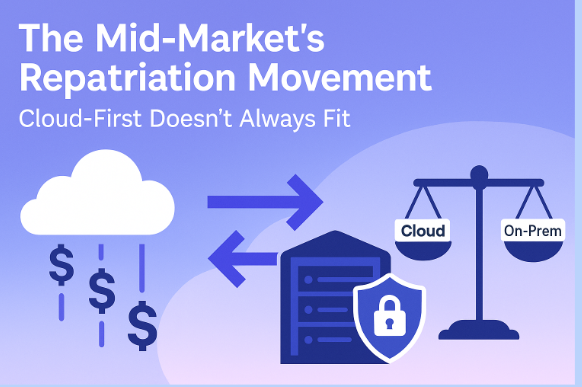
For more than a decade, “cloud-first” has been the gospel of IT strategy. From boardrooms to DevOps war rooms, the message was clear: If you’re not building in the cloud, you’re not building for the future.
And to be fair, the hyperscalers delivered. AWS, Azure and Google Cloud gave enterprises global scale, startups infinite elasticity, and developers a playground of APIs and managed services. The pandemic only reinforced the mantra: Remote work and digital acceleration leaned on cloud like never before.
But here’s the inconvenient truth: Cloud-first doesn’t always fit — especially for the mid-market.
In recent years, we’ve started to hear a different kind of story. Companies are pulling workloads back from the public cloud to on-premises data centers or colocation facilities. It’s called repatriation, and while it’s not about abandoning the cloud, it is about admitting that the one-size-fits-all narrative doesn’t hold up when you’re a $200M manufacturer, a regional healthcare provider or a 1,500-person SaaS firm.
The Mid-Market Squeeze
Large enterprises can afford it all. They have multi-cloud teams, FinOps specialists and custom contracts to smooth out hyperscaler bills. Startups, on the other hand, live fully cloud-native with minimal overhead, happy to trade cost predictability for velocity.
But mid-market firms live in the tension. They’re big enough to feel the weight of scale but small enough that every line item on the cloud bill matters. They don’t get the discounts of Fortune 50s, nor the nimbleness of startups. And they often lack the deep bench of cloud engineers who can fine-tune workloads across services and regions.
For them, cloud bills sting harder. Vendor lock-in feels scarier. And the complexity of hyperscaler menus — 500 services, overlapping SKUs, Byzantine pricing — quickly turns into operational drag.
Why Repatriation?
The drivers aren’t mysterious:
- Cost. Cloud bills are unpredictable, especially when egress fees and per-request pricing pile up. Andreessen Horowitz’s 2021 piece, The Cost of Cloud, a Trillion Dollar Paradox, laid this out bluntly: At scale, renting compute can be more expensive than owning it. For mid-market orgs, that paradox hits earlier and harder.
- Performance. Latency-sensitive workloads, high-throughput data pipelines, or steady-state applications often run better and cheaper on bare metal or colocation racks. 37signals (the makers of Basecamp and HEY) made waves when they repatriated workloads to custom hardware, claiming millions in annual savings.
- Compliance. Regional data residency rules, industry regulations and customer trust increasingly push workloads into environments where companies maintain tighter control. Healthcare and financial services in particular are wary of letting sensitive data float in someone else’s cloud.
- Predictability. Owning infrastructure — even via colocation — feels more stable than rolling the dice on hyperscaler pricing models that seem to change overnight.
Hybrid, Not Binary
Let’s be clear: repatriation isn’t about rejecting cloud outright. It’s about balance.
Mid-market orgs aren’t dumping SaaS for email or collaboration. They’re not giving up cloud-based AI services or analytics pipelines. What they are doing is pulling predictable, steady-state workloads back on-prem or into colocation. Think ERP systems, batch processing and long-lived databases.
The result looks less like “cloud vs. on-prem” and more like hybrid by necessity. SaaS and elastic workloads stay in the cloud. Cost-sensitive, latency-critical, or regulated workloads come back home.
It’s a different flavor of hybrid than what the big enterprises talk about. For them, hybrid is about choice, resilience and compliance across regions. For the mid-market, it’s about survival and sanity.
Vendors Smell Opportunity
This repatriation current hasn’t gone unnoticed. Colocation providers are marketing themselves as “cloud-adjacent” platforms, promising the best of both worlds: physical control plus direct connectivity to hyperscalers. Managed service providers are dusting off their on-prem offerings and layering in managed Kubernetes and cloud-native tooling to lure workloads back.
Even the hyperscalers themselves are hedging. AWS Outposts, Azure Stack HCI, Google Anthos — all attempts to push cloud APIs and operational models into customer data centers. Ironically, the same hyperscalers that once preached “ditch your data center” now want to manage what stays behind.
And then there are the Neoclouds — Snowflake, Databricks, Cloudflare, Vercel — who live above the hyperscalers and promise better developer experiences regardless of where the infrastructure sits. They don’t mind if you keep some workloads in colo; they just want to abstract the pain away.
The Hard Parts of Coming Home
Of course, bringing workloads back isn’t a panacea.
Running infrastructure takes skills that many mid-market IT teams don’t have. Buying servers means CapEx, not OpEx. Observability, identity, and security policies must now span multiple environments. And culturally, the cloud-first mantra is still strong in boardrooms—CIOs may have to fight uphill battles to explain why “repatriation” isn’t failure but strategy.
Shimmy’s Take
“Cloud-first” was a rallying cry, not a universal law. For some workloads, cloud-first still makes perfect sense. But for many mid-market firms, it’s become a mismatch between cost, complexity, and control.
Repatriation doesn’t mean giving up on the cloud. It means using it wisely. It means keeping cloud for what it does best — elasticity, innovation, global reach — and pulling back what cloud does poorly — predictable workloads at unpredictable cost.
The future isn’t binary. It’s hybrid. It’s poly-cloud. It’s cloud-adjacent. The winners won’t be the ones who cling to ideology, but the ones who treat cloud as a tool, not a religion.
Because at the end of the day, the goal isn’t to be “cloud-first.” The goal is to be business-first.


